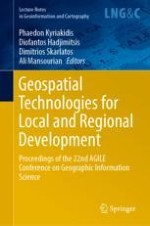2020 | Buch
Geospatial Technologies for Local and Regional Development
Proceedings of the 22nd AGILE Conference on Geographic Information Science
herausgegeben von: Prof. Phaedon Kyriakidis, Prof. Diofantos Hadjimitsis, Dr. Dimitrios Skarlatos, Dr. Ali Mansourian
Verlag: Springer International Publishing
Buchreihe : Lecture Notes in Geoinformation and Cartography
